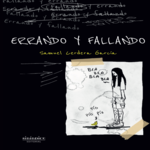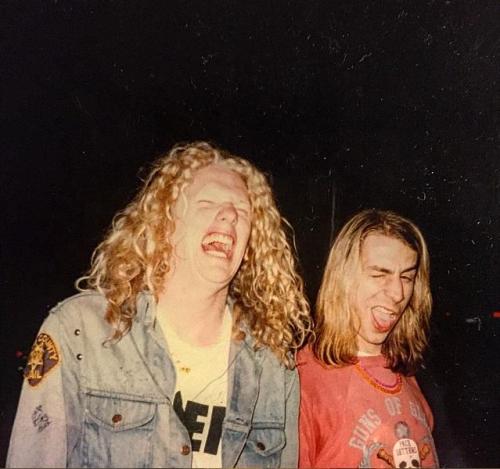Nueva biografía de Alice In Chains habla sobre cómo Layne y Kurt Cobain compartieron heroina
‘Alice in Chains: The Untold Story’ reveals the drug-addicted history of one of the greatest grunge bands

Sacado de // From: http://www.nydailynews.com/ – http://portalternativo.com
Se pone a la venta esta semana una biografía sobre Alice In Chains titulada “Alice in Chains: The Untold Story” escrita por David de Sola. La periodista Sherryl Connelly, del New York Daily News, ha escrito un artículo al respecto destacando algunas anécdotas que recoge.
Por ejemplo, durante un concierto en Brasil de Nirvana y Alice In Chains, Kurt Cobain y Layne Staley, ambos con un grave problema de adicción, vieron como en el país carioca era sencillo obtener cocaína pero no pasaba lo mismo con la heroína. Así, los músicos llegaron a un acuerdo: Cobain pagaba el producto y Staley el coste de que se lo trajeran. A poco que se lo hubieran propuesto podrían haber iniciado el Amazon de las drogas.
Aquella noche, el bajista Mike Starr, que acababa de ser despedido del grupo, asegura que murió y resucitó tras chutarse con ambos músicos, según recordaba el propio Starr:
Layne me chutó primero un par de veces. Luego Kurt me chutó y luego Layne me volvió a chutar, tras lo cual estuve muerto durante unos 11 minutos.
Staley fue hallado muerto, sin dientes y pesando solo 40 kilos en 2002; Starr en 2011 por sobredosis de pastillas, poco tiempo después de aparecer en un par de programas de telerrealidad en los que famosos y pseudo-famosos trataban de superar sus adicciones.
Asegura el artículo que dos cosas cambiaron para siempre la vida de Staley: cuando su novia, Demri Lara Parrott, empezó a pincharse heroína y cuando Alice In Chains alcanzaron la fama. Fue en 1991, cuando su banda teloneaba a Van Halen, que el vocalista empezó a drogarse con heroína. Sus problemas con la heroína crecieron a pasos agigantados: el oscuro “Dirt” era resultado de ello. De hecho, Staley ya había pasado por rehabilitación, la primera de casi una docena de veces hasta su muerte. Fue durante la grabación del citado álbum que el cantante se iba a buscar heroína en una ciudad de Los Angeles completamente patas arribas por los disturbios a causa de la muerte de Rodney King.
Por su parte, el batería Sean Kinney seguía viviendo las giras a tope. Recuerda un amigo:
Cuando Sean se ponía a tono era imparable. Era el clásico destroza-habitaciones de hotel.
El músico recuerda que tenía un alter ego llamado Steve que se subía a una silla en un restaurante de alta clase y se meaba en la carta de postres o rociaba los candelabros decorativos de los pasillos de los hoteles con cerveza para ver como explotaban segundos después.
El bajista Mike Starr llegó a beber de una botella de lejía usada para limpiar jeringuillas creyendo que era agua por lo que terminó en el hospital.
Staley seguía con lo suyo: Alice In Chains andaba de gira en 1993 y el vocalista se iba a mitad de canción para colocarse. La manager del grupo, Susan Silver, discutió con el cantante y le exigió que saliera al escenario para decirle al público que como estaba tan hecho polvo no iba a poder seguir con el concierto.
La última actuación pública de Staley fue en Kansas City en 1996, tras la cual sufrió una sobredosis. Y eso, pese a viajar con un guardaespaldas cuya función era mantenerle alejado de las drogas.
Kinney recuerda:
Solo fueron cinco o seis conciertos y para el final del último, la cosa fue policías, ambulancias y “¡Sube al avión! ¡Esconde las drogas!” La misma mierda se repetía una y otra vez.
El artículo menciona también la demanda que la madre de Staley interpuso tras su muerte y en la que aseguraba que el vocalista quiso dejar el grupo temporalmente para superar sus adicciones pero la manager del grupo le hizo saber que si lo hacía iba a mandar al paro a 40 personas.
Staley y su novia si llegaron a ir juntos a rehabilitación sin que lograran su objetivo y, de hecho, terminaron separándose debido a que el músico era un mujeriego. Ella murió en 1996 después de que su por entonces compañero la llevara dando tumbos inconsciente durante horas hasta finalmente llegar a un hospital.
En 1998, Staley ya parecía estar en sus últimas. Apareció en el estudio de grabación sin dientes, esquelético y con aspecto de tener 80 años. Lo recuerda el productor Dave Jerden después de que Jerry Cantrell le pidiera que se quitara la ropa:
Layne, que tenía una personalidad fortísima, había quedado reducido a nada.
Posteriormente, el vocalista era visto ocasionalmente con llagas abiertas en sus brazos mientras dedicaba su vida a quedarse recluido en su apartamento, jugando a videojuegos y drogándose, con la única compañía de su gato.
Mike Starr fue probablemente el último en ver con vida a Staley: el 4 de abril de 2002, el bajista, puesto de benziodazepina, se ofreció para llamar al 911. Staley, sin embargo, le gritaba cada vez que trataba de tomar más pastillas y Starr se marchó enfadado del piso de su ex-compañero de banda.
El día siguiente, el frontman de Alice In Chains se chutó una mezcla de heroína y cocaína en vena que le provocó la muerte. No fue hasta unos días después que su contable, al comprobar que hacía tiempo sin que el músico sacara dinero, decidió llamar a la policía.
Al entrar en la vivienda, la policía se encontró a Staley en el sofá iluminado por los destellos de la TV, con una jeringuilla en la mano y sentado encima de otras usadas. También había un alijo de cocaína y dos pipas de crack encima de la mesa. Para terminar de dar ambiente al lugar, había un reguero de manchas marrones de heroína que venían del lavabo al salón.
Un final que no por esperado fue menos traumático.
Si queréis ver como empieza el libro, aquí podéis leeros el primer capítulo.
IN ENGLISH
Alice in Chains was the first of grunge’s big four to break out, but Nirvana clearly won the to-the-death competition.
Kurt Cobain short-circuited death by heroin with a shotgun blast to the head in 1994. It took Layne Staley, Alice in Chains’ lead singer, a while longer to kill himself with a speedball.
One of the many drenched-in-drug moments revealed in David de Sola’s new book, “Alice in Chains: The Untold Story,” has Cobain and Staley striking a deal while the bands were on tour in Rio de Janeiro.
To their shock and dismay, the two addicts discovered there was almost an excess of cocaine to be had in Brazil but no smack. Cobain agreed to pay for the product if Staley shouldered the cost of having it flown in.
That night, Alice in Chains bassist Mike Starr, who had just been tossed from the band, claimed he actually died and came back as he bounced from shooting up with one famed musician to the other.
“Layne shot me up first a couple of times. Then Kurt shot me, and then Layne shot me after that and I died, for like 11 minutes.”
And those were the good times.
Staley was found dead, toothless and weighing only 86 pounds, in his Seattle apartment in 2002. Starr, after a stint on VH1’s “Celebrity Rehab With Dr. Drew” and “Sober House,” overdosed on prescription drugs in 2011.
Both Jerry Cantrell, the other engine driving Alice in Chains, and drummer Sean Kinney openly talk about their sobriety these days, but are none too specific about the substances, other than booze, at the source of their addictions.
Actually, the best of times was when everyone was just strung out on booze, coke and sex — the basic musts on any rocker’s CV.
One of the purely amusing anecdotes de Sola shares concerns the night the Music Bank, the rehearsal warehouse where the band rented space, was raided in 1988.
Layne turned a corner with two strippers into a hallway crowded with cops.
“They were obviously coked out because they (the strippers) started b—-ing up one side and down the other to the point where Layne actually told them to shut up because they were making it worse than it needed to be,” according to one observer.
Back in those days, the band lived in abject poverty, “obsessed with getting p—y and who they were f—–g.”
Then, two things changed. Staley’s girlfriend, Demri Lara Parrott, started shooting smack — and Alice in Chains got famous.
Alice in Chains was opening for Van Halen on tour in 1991 when Staley, prompted by Parrott, started using.
On one hand, the two bands got up to some hilarious business pranking each other. One night, Alice in Chains dressed up as strippers in skimpy panties and combat boots, and followed Van Halen on stage, aping their signature walk.
On the other, Staley’s affair with heroin got serious fast. By the next year, the band’s dark and deeply pained breakthrough album, “Dirt,” was rife with references to the drug. At that point, Staley had already been to rehab after an intervention.
Then he relapsed again. Close to a dozen more stints in rehab were in his future. But when the band was recording in Los Angeles during the Rodney King riots in 1992, Staley would hit the scary streets, desperate to score.
For the first time, there were problems with his vocals. He hadn’t yet mastered singing high. Staley created a personal shrine in the recording studio featuring a dead puppy in a jar that he used for inspiration as he crooned lyrics like “Stick your arm for some real fun.”
Kinney, though, continued to have fun the old-fashioned way on the Shi–y Cities tour in 1992.
“When Sean got lit he was pretty unstoppable,” a friend says. “He was sort of a classic destroyer of hotel rooms.”
Meanwhile, Starr, who’d been introduced to heroin by Staley, drank a bottle of bleach used for cleaning syringes, thinking it was water. He ended up in the hospital.
In 1993, when the band was touring in support of “Dirt,” Staley would walk offstage midsong to get high. Band manager Susan Silver told Staley that he had to be the one to break it to ticket buyers that the concert was going to end midperformance because he was too screwed up to carry on.
“There is no f—–g way I’m going to do that,” he shouted.
“I pay you,” she screamed back. “Go f—–g do it now.”
That was the last time Staley would do a major tour.
Courtney Love tried to chase him down following Cobain’s death. She wasn’t happy with the suicide ruling and wondered what more there might be to the story. Since both Staley and Cobain were smackheads and ran with the same musicians, the assumption was he might know something. What’s not known is if they finally connected.
Staley’s final public performance was in Kansas City, Mo., in 1996. He was traveling with a bodyguard hired specifically to keep his drug use in check, but after the show he overdosed.
“It was only five or six shows, and by the end of the last one, it was cops, ambulances, and, ‘Get on the plane! Hide the drugs!’ ” Kinney recalls. “The same s–t was going on again.”
In a lawsuit filed after Staley’s death, his mother, Nancy Layne McCallum, alleged that at one point in the mid-’90s, her son tried to withdraw from the band to take care of his issues, but Silver forcefully pointed out that if he did, he would be putting 40 people out of work.
Staley and Parrott, by then his fiancée, went to rehab together at least once. They broke up, in part because she couldn’t accept his relentless womanizing. By the end, she was living with an older man who bizarrely drove her around unconscious for several hours before getting help. She died in the hospital late in 1996.
By 1998, Staley already seemed on last legs. He showed up in the recording studio toothless, emaciated and looking like an 80-year-old man.
Producer Dave Jerden watched as Staley disintegrated after a dressing-down from Cantrell: “Layne, who had such a strong personality, had completely turned into this nothing.”
There would be occasional sightings of Staley after that with open sores on his arms. Mainly, he holed up in his apartment, gaming, playing with his cat and doing drugs.
Starr was likely the last one to see him alive. On April 4, 2002, Starr, high on benzodiazepine, offered to call 911. Staley erupted, then yelled at him whenever he tried to take more pills. Finally, Starr left angry.
The autopsy later revealed that the next day Staley plunged a speedball into his vein. Days passed before his accountant sent up an alert that Staley hadn’t been withdrawing any money.
The police broke down the door.
Staley was on the sofa, illuminated by a flickering television. He was holding a loaded syringe and was sitting on a batch of used ones. There was a stash of cocaine and two crack pipes on the table. Brown heroin stains led from the bathroom to the living room.


